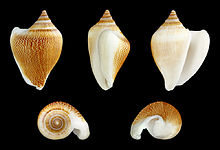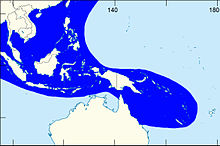Laevistrombus canarium
| Laevistrombus canarium | |
|---|---|

| |
| Five different views of a shell of an adult L. canarium: abapertural (upper left), right lateral (center), apertural (upper right), apical (lower left) and basal (lower right) | |
| Scientific classification | |
| Domain: | Eukaryota |
| Kingdom: | Animalia |
| Phylum: | Mollusca |
| Class: | Gastropoda |
| Subclass: | Caenogastropoda |
| Order: | Littorinimorpha |
| Family: | Strombidae |
| Genus: | Laevistrombus |
| Species: | L. canarium
|
| Binomial name | |
| Laevistrombus canarium | |

| |
| The shaded area indicates the distribution of Laevistrombus canarium within the Western Central Pacific, according to Poutiers, 1998.[1] | |
| Synonyms[1][4][5][6] | |
Laevistrombus canarium (
The external anatomy of the soft parts of this species is similar to that of other strombid snails. The animal has an elongated
L. canarium lives on muddy and sandy bottoms, grazing on
The dog conch is an economically important species in the
.Name
The English common name of L. canarium, "dog conch", is a calque of the Malay. In the Malay Peninsula, the species is known by the Malay name siput gonggong, where siput means "snail" and gonggong is an onomatopoetic word for a dog's bark.[4][7][8]
Taxonomy

The first published depictions of the shell of this species appeared in 1681 in the earliest book solely about
In 1758, the dog conch was formally
The taxon Laevistrombus was introduced in the literature as a
The
Anatomy
Shell description
Laevistrombus canarium has a heavy shell with a rounded outline. The shell length of adult specimens is from 29 mm (1.1 in) to 71 mm (2.8 in).
Shell colour is variable, from golden yellow to light yellowish-brown to grey. The underside of the shell is rarely dark; more frequently it is paler than the top, or totally white. In all cases, the shell
Soft parts
Females of L. canarium are generally larger (both shell and soft parts) than males, which is also the case in other
Phylogeny
| |||||||||||||||||||||||||||||||||||||||||||||||||||||||||||||||||||||||||||
| Part of the phylogeny and relationships of Strombus species, according to Latiolais and colleagues (2006)[18]
|
In 2006, Latiolais and colleagues proposed a
Distribution
L. canarium is native to the coastal waters of the Indo-Pacific region.
Detailed information is available about its distribution in the
Behaviour
Compared to most other gastropods, L. canarium has an unusual means of locomotion that is common only among the Strombidae. This curious series of maneuvers was originally described by American zoologist George Howard Parker in 1922. The animal initially fixes the posterior end of the foot by thrusting the point of its sickle-shaped operculum into the substrate. Then, it extends its foot forward, lifting the shell and throws it ahead in a motion that has been described as "leaping".[17][23]
Burrowing behaviour, in which an individual sinks itself entirely (or partially) into the substrate, is frequent among strombid gastropods.[24] The burrowing behaviour of L. canarium consists of a series of movements characteristic of the species. There are three consecutive movements: first is probing, where the animal pushes the anterior portion of the foot into the substrate to gain a hold; next is shovelling, where it pushes the substrate with its long, extensible proboscis. Retraction is the final movement, where it moves the shell along an anterior-posterior axis to settle the substrate around it. Once burrowed, part of the dorsal shell is usually still visible (although the ventral surface and the animal's soft parts are buried).[24]
The
Ecology
The dog conch lives on muddy sand bottoms among

During the 19th century, strombid gastropods were believed to be
Many
L. canarium is often
Life cycle
L. canarium is
A study from 2008 indicates that
Human uses and conservation measures

The flesh of the dog conch is edible. It is a
-
L. canarium is a local delicacy in the Malay Peninsula. Dog conchs are boiled with lemongrass and can be eaten with white rice.
-
Dog conchs served in a seafood restaurant near Johor Bahru, Malaysia
References
- ^ ISBN 978-92-5-104051-5.
- ^ a b Linnaeus, C. (1758). Systema Naturae. Vol. 1 (10 ed.). Stockholm, Sweden: Laurentii Salvii. p. 745.
- ^ Issel, A.; Tapparone-Canefri, C. M. (1876). "Studio monografico sopra gli strombidi del Mar Rosso". Annali del Museo Civico di Storia Naturale di Genova (in Italian). 8: 337–366.
- ^ a b c d e f g Cob, Z. C.; Arshad, A.; Bujang, J. S.; Ghaffar, M. A. (2009). "Species description and distribution of Strombus (Mollusca: Strombidae) in Johor Straits and its surrounding areas" (PDF). Sains Malaysiana. 38 (1): 39–46. Archived from the original (PDF) on 2011-07-22.
- ^ a b c d e f Man In 'T Veld, L. A.; De Turck, K. (1998). "Contributions to the knowledge of Strombacea. 6. A revision of the subgenus Laevistrombus Kira, 1955 including the description of a new species from the New Hebrides". Gloria Maris. 36 (5–6): 73–107.
- ^ S2CID 73456300. Retrieved 21 February 2023.
- ^ ISBN 978-981-04-3073-3.
- ^ Tan, R. (2008). "Online guide to Check Jawa: Gong-gong". Wild Singapore: Wild Fact Sheets. Retrieved 24 December 2012.
- ^ Robertson, R. (2012). "Buonanni's Chiocciole (1681)". Digital collections from the Ewell Sale Stewart Library and Archives. The Academy of Natural Sciences of Drexel University, Philadelphia, USA. Archived from the original on 14 January 2013. Retrieved 20 December 2012.
- ^ a b Buonanni, F. (1684). Recreatio Mentis, et Oculi in Observatione Animalium Testaceorum Italico Sermone Primum Proposita ... nunc ... Latine Oblata Centum Additis Testaceorum Iconibus (in Latin). Rome, Ex typographia Varesii. pp. 431–432 (plates 146 and 147).
- ^ Brown, R. W. (1954). Composition of Scientific Words. Baltimore, Maryland, USA: Published by the author. p. 275.
- ^ Kira, T. (1955). Coloured Illustrations of the Shells of Japan. Osaka, Japan: Hoikusha. p. 204.
- ^ Bieler, R.; Petit, R. E. (1996). "Additional notes on nomina first introduced by Tetsuaki Kira in "Coloured Illustrations of the Shells of Japan"". Malacologia. 38 (1–2): 33–34.
- ^ Abbott, R. T. (1960). Indo-Pacific Mollusca Volume 1: The Genus Strombus in the Indo-Pacific. Philadelphia, USA: Academy of Natural Sciences of Drexel University. pp. 33–146.
- ^ Sepkoski, J. J. Jr. (2002). "A compendium of fossil marine animal genera". Bulletins of American Paleontology. 363: 95.
- ^ Tryon, G. W. (1885). Manual of Conchology, Structural and Systematic, with Illustrations of the Species. Vol. 7. Philadelphia, USA: Published by the author. p. 350.
- ^ a b c d e f g Cob, Z. C.; Arshad, A.; Ghaffar, M. A.; Bujang, J. S.; Muda, W. L. W. (2009). "Development and growth of larvae of the dog conch, Strombus canarium (Mollusca: Gastropoda), in the laboratory" (PDF). Zoological Studies. 48 (1): 1–11.
- ^ S2CID 9009475.
- ^ Bouchet, P. (2012). "Doxander vittatus (Linnaeus, 1758)". World Register of Marine Species - WoRMS. Flanders Marine Institute, Belgium. Retrieved 19 December 2012.
- ^ Bouchet, P.; Rosenberg, G. (2012). "Labiostrombus epidromis (Linnaeus, 1758)". World Register of Marine Species - WoRMS. Flanders Marine Institute, Belgium. Retrieved 19 December 2012.
- ^ a b c d Cob, Z. C.; Arshad, A; Sidik J. B; Amin, S. M. N.; Ghaffar, M. A. (2008). "Growth, mortality, recruitment and yield-per-recruit of Strombus canarium Linnaeus, 1758 (Mesogastropoda: Strombidae) from the West Johor Straits, Malaysia". Research Journal of Fisheries and Hydrobiology. 3 (2): 71–77.
- ISBN 978-81-85874-72-2.
- .
- ^ ISSN 0341-0145.
- ^ PMID 5956601.
- ISBN 978-0-87893-097-5.
- ISBN 978-0-643-05756-2.
- ^ Limpalaër, L. (2000). "Le complexe de Strombus canarium". Xenophora (in French) (92): 24–28.
- ^ S2CID 85126360.
- ISBN 978-1-4020-2942-4.
- ^ a b c Cob, Z. C.; Arshad, A.; Idris, M. H.; Bujang, J. S.; Ghaffar, M. A. (2008). "Sexual polymorphism in a population of Strombus canarium Linnaeus, 1758 (Mollusca: Gastropoda) at Merambong Shoal, Malaysia" (PDF). Zoological Studies. 47 (3): 318–325.
- ^ a b Robertson, R. (1961). "The feeding of Strombus and related herbivorous marine gastropods". Notulae Naturae of the Academy of Natural Sciences of Philadelphia (343): 1–9.
- PMID 23042618.
- .
- ^ PMID 29360442.
- S2CID 85612140.
- ISSN 1252-607X.

- ISBN 978-0-87893-097-5.
- ^ Purchon, R. D.; Purchon D. E. A. (1981). "The marine shelled Mollusca of West Malaysia and Singapore. Part I. General introduction and account of the collecting stations". Journal of Molluscan Studies. 47 (3): 290–312. Archived from the original (abstract) on 2013-05-07.
- ^ a b Choksakulpan, P. (May 2010). "Phuket bids to save the dog conch". Phuket Gazette. Phuket, Thailand. Retrieved 29 September 2018.
- ^ S2CID 207130813.
- ^ ISSN 1516-8913.
External links
 Media related to Laevistrombus canarium at Wikimedia Commons
Media related to Laevistrombus canarium at Wikimedia Commons- "Laevistrombus canarium". Gastropods.com. Retrieved 23 March 2011.


